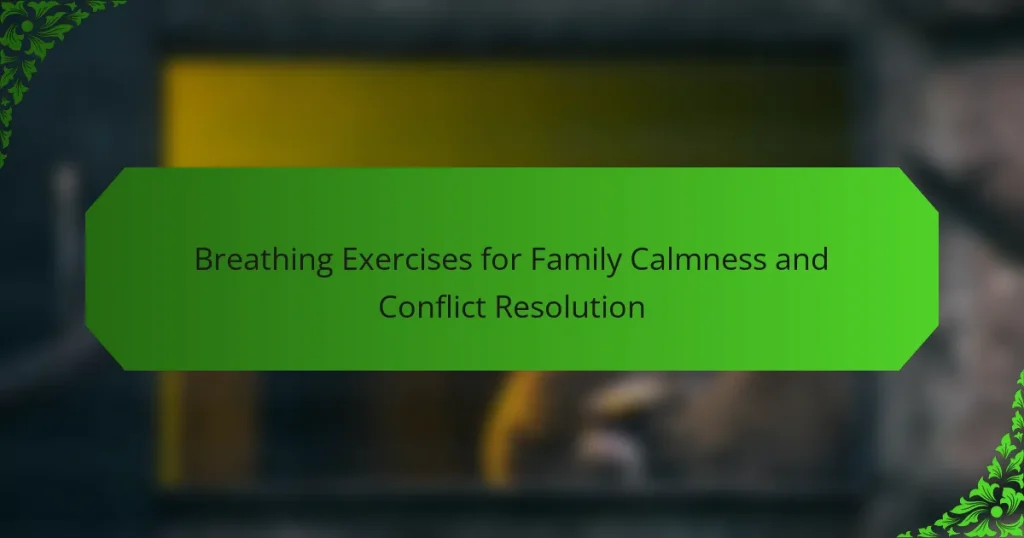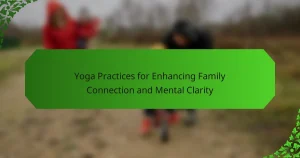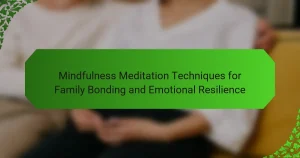Breathing exercises can enhance family calmness and improve conflict resolution. Techniques such as deep belly breathing, box breathing, and the 4-7-8 method promote relaxation and mindfulness. These exercises are simple, accessible, and adaptable, making them suitable for all family members. Regular practice fosters better communication and strengthens emotional bonds among family members.
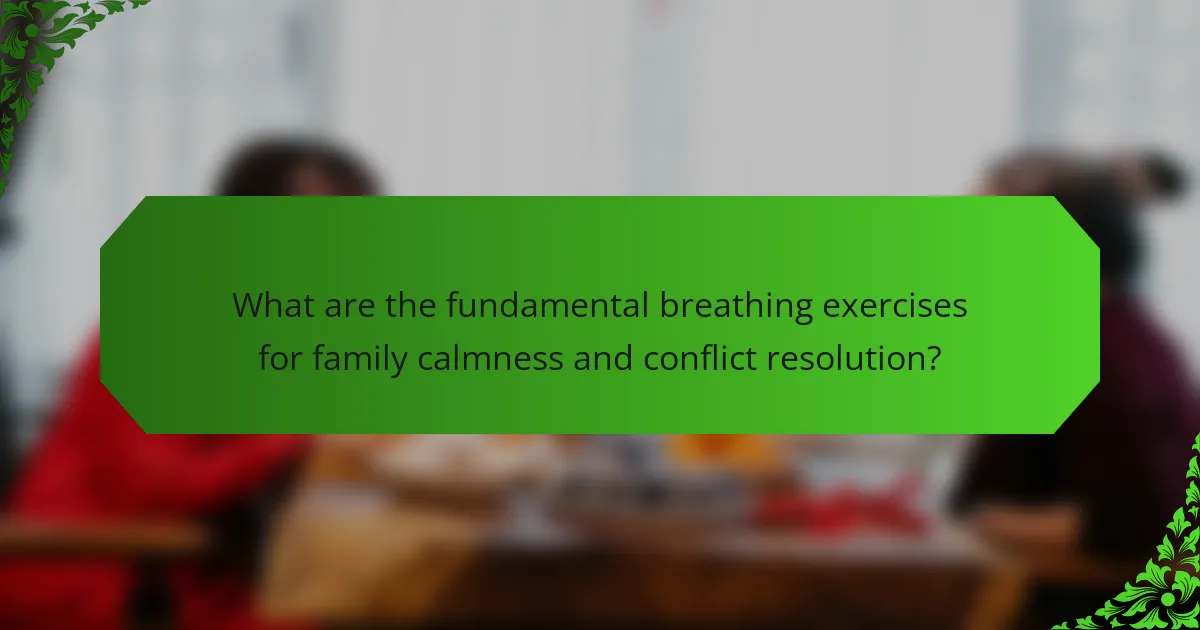
What are the fundamental breathing exercises for family calmness and conflict resolution?
Breathing exercises can significantly enhance family calmness and aid in conflict resolution. Techniques such as deep belly breathing, box breathing, and 4-7-8 breathing promote relaxation and mindfulness.
Deep belly breathing involves inhaling deeply through the nose, expanding the diaphragm, and exhaling slowly through the mouth. This method reduces stress and fosters a sense of connection among family members.
Box breathing consists of inhaling for a count of four, holding for four, exhaling for four, and holding again for four. This structured approach helps regulate emotions and encourages patience during conflicts.
The 4-7-8 technique requires inhaling for four counts, holding for seven, and exhaling for eight. This unique attribute of extended exhalation calms the nervous system and can be particularly effective in tense situations.
Practicing these exercises regularly can cultivate a peaceful family environment, facilitating better communication and conflict resolution.
How do breathing exercises promote emotional regulation in families?
Breathing exercises enhance emotional regulation in families by fostering calmness and reducing conflict. These exercises promote mindfulness, allowing family members to manage stress effectively. For instance, deep breathing activates the parasympathetic nervous system, which decreases anxiety levels. As a result, families experience improved communication and understanding. Regular practice of these exercises can create a unique family dynamic, encouraging emotional resilience and empathy among members.
What role do breathing techniques play in reducing family conflicts?
Breathing techniques significantly reduce family conflicts by promoting calmness and emotional regulation. These exercises help family members manage stress and enhance communication. Deep breathing lowers cortisol levels, fostering a peaceful environment. Practicing together can strengthen bonds and create a shared sense of tranquility.

What are the common attributes of effective breathing exercises?
Effective breathing exercises share common attributes that enhance family calmness and conflict resolution. These include simplicity, accessibility, and adaptability.
Simplicity allows participants of all ages to engage without prior experience. Accessibility ensures that exercises can be performed anywhere, making them practical for family settings. Adaptability enables exercises to be tailored to individual needs, promoting inclusivity and personal comfort.
Additionally, many effective breathing exercises incorporate rhythmic patterns, which foster relaxation and focus. This rhythmic quality serves as a unique attribute, enhancing the calming effect during stressful situations.
What types of breathing exercises are widely used for family calmness?
Breathing exercises widely used for family calmness include deep breathing, box breathing, progressive muscle relaxation, and diaphragmatic breathing. These exercises promote relaxation and enhance emotional regulation among family members.
Deep breathing involves inhaling deeply through the nose, holding the breath, and exhaling slowly through the mouth. Box breathing consists of four equal parts: inhaling, holding, exhaling, and holding again, each for a count of four. Progressive muscle relaxation encourages families to tense and then relax different muscle groups, fostering a sense of calm. Diaphragmatic breathing focuses on engaging the diaphragm, which can reduce stress and anxiety levels.
Incorporating these exercises into family routines can significantly improve communication and reduce conflict. Regular practice builds resilience and emotional intelligence, creating a more harmonious home environment.
What are the step-by-step methods for practicing deep breathing?
To practice deep breathing effectively, follow these step-by-step methods.
1. Find a quiet space to sit or lie down comfortably.
2. Close your eyes and take a slow, deep breath in through your nose for a count of four.
3. Hold your breath for a count of four.
4. Exhale slowly through your mouth for a count of six.
5. Pause for a moment before inhaling again.
6. Repeat this cycle for five to ten minutes.
These methods help promote calmness and can aid in conflict resolution within family dynamics.
How can paced breathing techniques be applied in family settings?
Paced breathing techniques can effectively promote calmness and resolve conflicts in family settings. These exercises help family members manage stress and communicate better during tense moments. For instance, practicing deep breathing together can create a shared sense of tranquility, making it easier to address disagreements constructively.
One approach is to set aside specific times for family breathing sessions. This routine encourages a peaceful atmosphere and reinforces emotional connections. Additionally, teaching children to use paced breathing in conflict situations empowers them to handle their emotions independently.
Incorporating breathing techniques into family activities, such as during meals or before bedtime, can enhance overall family cohesion. Regular practice fosters a supportive environment where open communication thrives, ultimately leading to healthier relationships.
What are the benefits of incorporating breathing exercises into family routines?
Incorporating breathing exercises into family routines enhances calmness and improves conflict resolution. These exercises promote emotional regulation, reduce stress, and foster a supportive environment. Families practicing together can strengthen bonds and improve communication skills. Research shows that regular breathing techniques can lower anxiety levels, making family interactions more positive.
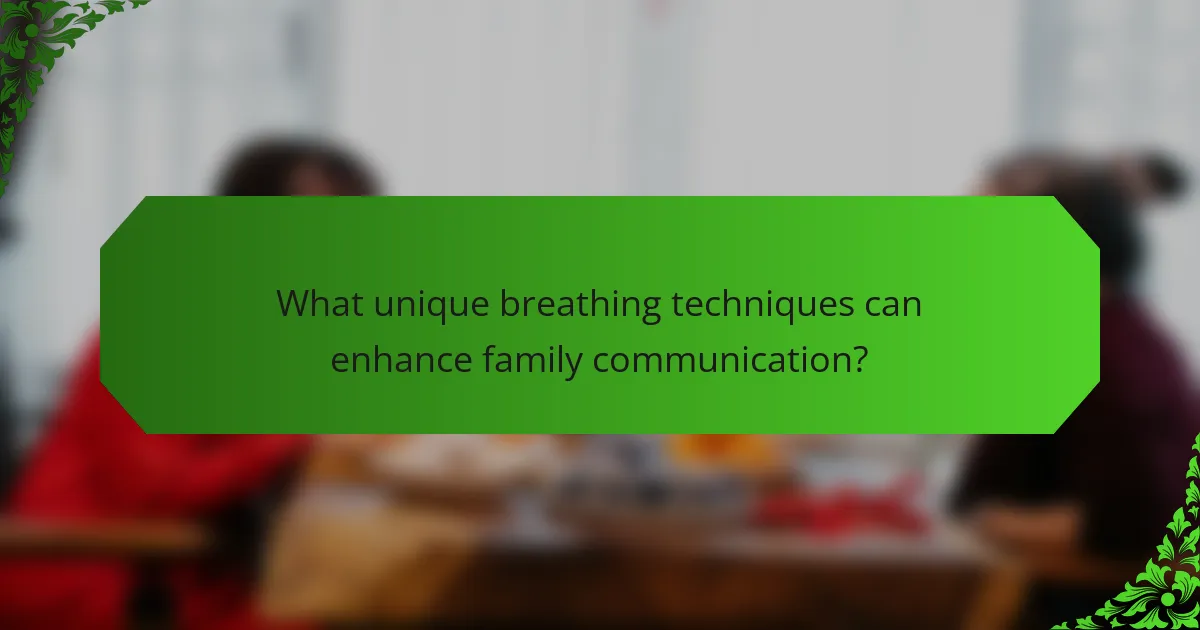
What unique breathing techniques can enhance family communication?
Breathing techniques can significantly enhance family communication by promoting calmness and reducing tension. Techniques such as deep belly breathing, box breathing, and alternate nostril breathing foster a tranquil environment.
Deep belly breathing involves inhaling deeply through the nose, allowing the abdomen to expand, and exhaling slowly. This technique reduces stress and encourages open dialogue. Box breathing consists of inhaling for four counts, holding for four counts, exhaling for four counts, and holding again for four counts, creating a rhythmic pattern that calms nerves. Alternate nostril breathing balances the body’s energy and helps family members feel more centered during discussions.
Incorporating these techniques into family interactions can lead to more constructive conversations and improved emotional understanding. Regular practice may also strengthen family bonds and enhance conflict resolution skills.
How can visualization during breathing exercises improve family interactions?
Visualization during breathing exercises enhances family interactions by fostering emotional connection and reducing tension. This practice encourages mindfulness, allowing family members to express feelings openly. As a result, conflicts are resolved more peacefully, promoting a calm atmosphere. Visualization techniques, such as imagining a serene landscape, can help individuals focus on positive emotions, enhancing communication and empathy among family members. By integrating these exercises into family routines, lasting bonds are strengthened, creating a supportive environment for healthy interactions.
What specific breathing patterns are effective for conflict resolution?
Deep, diaphragmatic breathing patterns are effective for conflict resolution. These techniques promote relaxation and enhance emotional regulation during tense situations.
1. **4-7-8 Breathing**: Inhale for 4 seconds, hold for 7 seconds, exhale for 8 seconds. This pattern calms the nervous system.
2. **Box Breathing**: Inhale for 4 seconds, hold for 4 seconds, exhale for 4 seconds, hold for 4 seconds. This method fosters focus and clarity.
3. **Equal Breathing**: Inhale and exhale for the same duration, typically 5-6 seconds. This technique stabilizes emotions and reduces anxiety.
4. **Alternate Nostril Breathing**: Inhale through one nostril, exhale through the other. This practice balances energy and promotes calmness.
Incorporating these breathing patterns into family interactions can significantly improve communication and reduce conflict.

What rare but impactful breathing exercises exist for family dynamics?
Breathing exercises can significantly enhance family calmness and conflict resolution. Rare but impactful techniques include the “4-7-8 Breathing,” which promotes relaxation, and “Box Breathing,” which aids in emotional regulation. Both exercises foster a peaceful environment and improve communication among family members.
How can laughter-focused breathing exercises foster family connection?
Laughter-focused breathing exercises can significantly enhance family connection by promoting joy and reducing stress. These exercises create shared experiences that foster bonding and improve communication. Engaging in laughter while practicing breathing techniques encourages a light-hearted atmosphere, making conflict resolution easier. Families that regularly participate in these exercises report greater emotional resilience and a deeper sense of unity.
What are the less common breathing techniques that can address anxiety in family members?
Less common breathing techniques that can help address anxiety include diaphragmatic breathing, box breathing, and alternate nostril breathing. These techniques encourage relaxation and emotional regulation.
Diaphragmatic breathing involves deep inhalations that engage the diaphragm, promoting calmness. Box breathing consists of four equal phases: inhale, hold, exhale, and hold again, which helps reduce stress. Alternate nostril breathing balances the body’s energy and calms the mind by alternating breaths through each nostril.
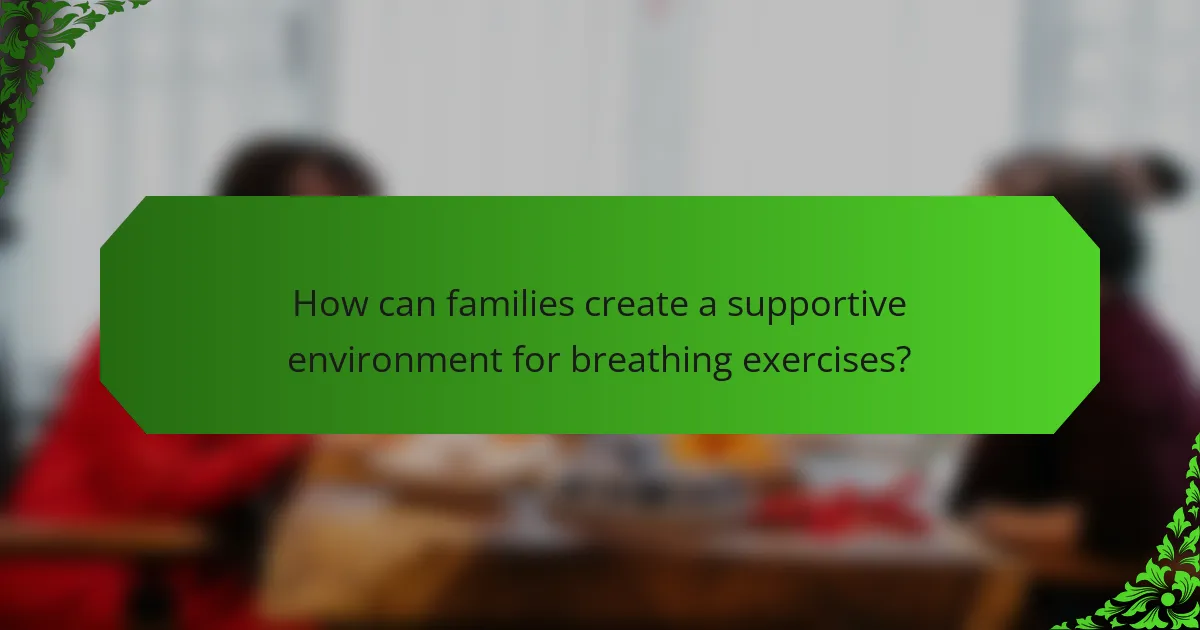
How can families create a supportive environment for breathing exercises?
Families can create a supportive environment for breathing exercises by establishing a calm, designated space and setting consistent times for practice. This encourages routine and reduces distractions.
Incorporating family participation enhances engagement. Parents can model breathing exercises, demonstrating techniques that promote relaxation. This shared experience fosters connection and understanding among family members.
Utilizing visual aids or calming music can further enhance the atmosphere. These elements make the practice more inviting and enjoyable, reinforcing the positive effects of breathing exercises on family calmness and conflict resolution.
Encouraging open discussions about feelings before and after exercises helps families process emotions together, creating a deeper emotional bond and understanding.
What strategies can families use to incorporate breathing exercises into daily life?
Families can effectively incorporate breathing exercises into daily life by establishing a routine. Designate specific times, such as morning or bedtime, for these exercises. Engage in group sessions to foster connection and ensure everyone participates. Use visual aids, like posters or apps, to guide the exercises and maintain interest. Encourage children to take turns leading the exercises, promoting ownership and responsibility. Integrate breathing exercises during stressful moments or conflicts, reinforcing their calming benefits. Additionally, create a relaxing environment by minimizing distractions, enhancing focus on the exercises.
What common mistakes should families avoid when practicing breathing exercises?
Families should avoid common mistakes like rushing through exercises, neglecting proper posture, and failing to communicate. These errors can hinder the effectiveness of breathing exercises for calmness and conflict resolution. Rushing reduces focus, while poor posture limits breath capacity. Additionally, open communication about feelings enhances the experience, making it more beneficial for family dynamics.
What expert tips can enhance the effectiveness of breathing exercises for families?
To enhance the effectiveness of breathing exercises for families, practice consistency, create a calm environment, and engage all family members. Establish a routine for these exercises to reinforce their importance. Choose a quiet space free from distractions to promote focus. Encourage participation by making the exercises enjoyable, integrating games or storytelling. Tailor techniques to suit different age groups, ensuring everyone feels included. Use visual aids or apps to guide sessions, making them interactive and engaging.
